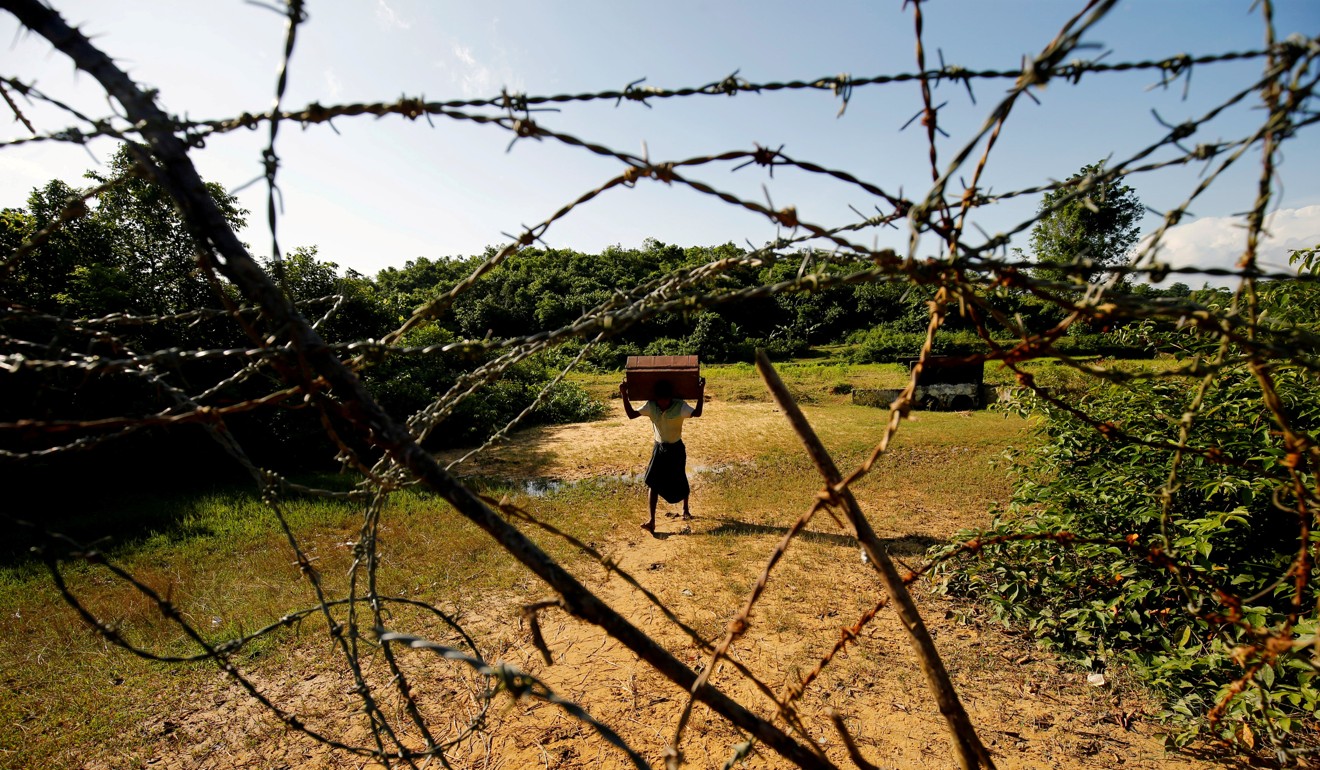
Kill all, burn all: the Japanese war tactic used on the Rohingya by Myanmar’s military
Tatmadaw troops ‘not schooled in the niceties of human rights’
The current crisis – the second major outbreak of violence in the northwestern province in the last year – was sparked after armed Rohingya insurgents took part in an August offensive targeting dozens of police posts and an army base in the northwestern region. Some 400 people have since been killed, and an estimated 150,000 have fled to neighbouring Bangladesh as a result of what is seen as a scorched earth counteroffensive by the military, known locally as the Tatmadaw.
Anthony Davis, a Bangkok-based security analyst with the defence publisher Jane’s, said the scale of the carnage in Rakhine was a result of several factors. These included an intrinsic ethnic bias in the Burman-Buddhist dominated Tatmadaw rank and file, their preference for targeting the insurgents’ civilian support base, and the fact that many security force personnel do not speak the local language. Burman-Buddhists make up some 70 per cent of Myanmar’s population of 51 million people.
In Rakhine, Myanmar’s poorest region, there are around 1.1 million Rohingya Muslims. While they are indigenous to the region, the minority group is technically stateless as the government considers them illegal immigrants from neighbouring Bangladesh.

The main insurgent group, the Arakan Rohingya Salvation Army, say their aim is to “defend, salvage and protect” the Rohingya from state repression. The group is said to be poorly armed, with the August attacks carried out with small arms, knives, sticks and swords.
In contrast, Davis said the Burman-dominated Tatmadaw’s killer instincts in the region, honed over decades of operations in border areas in the Kachin and Shan states, “are on steroids”.
“The population is not only Muslim – a red rag to a Burman Buddhist bull – but it’s also not even officially recognised as an ethnic minority,” said Davis, who specialises in insurgencies and terrorism in South and Southeast Asia.
One year on in Myanmar, is Suu Kyi’s halo slipping?
“In other words these are ‘Bengali Muslims’ who have no legal right to even live in the country,” he said. “As a result the ‘area clearance’ tactics applied are notably more brutal and more systematic than those seen in Kachin or Shan states.”
Phil Robertson, the Asia deputy director for Human Rights Watch, said the military operated on wartime Japan’s sanko seisaku tactics of “kill all, burn all, destroy all”.
“So the Tatmadaw target villages or areas that they suspect have a connection with insurgents and then punish everyone in it, essentially driving away the base of support for any insurgents they suspect might be there,” Robertson said.

Interviewed by Reuters on Friday in a refugee camp in Kutapalong, Bangladesh, some Rohingya villagers recounted the violence they faced by Rakhine Buddhists they claimed were set upon them by the Tatmadaw.
“The military brought some Rakhine Buddhists with them and torched the village,” said Kadil Hussein, 55. “All the Muslims in our village, about 10,000, fled. Some were killed by gunshots, the rest came here. There’s not a single person left.”
Robertson said the modus operandi was that “anyone running is a potential insurgent and should be shot”.
Men and boys are treated as insurgents and face torture, pre-emptive detention or extrajudicial execution, while women “are strip-searched in front of the others, sexually harassed and abused, and in some cases, led away and gang-raped,” Robertson said.
Human Rights Watch and other international rights group have been accused by the Myanmar government of overplaying the scale of the crisis. But the groups say their public statements on the military’s brutality are based on interviews with Rohingya refugees in Bangladesh and elsewhere. The groups’ findings are also based on satellite imagery.

Access to the troubled province for rights monitors, aid groups and journalists is severely restricted.
Davis, the insurgency researcher, said the troops stationed in Rakhine – from the 33rd and 99th Light Infantry Divisions – were “the sharp edge of Tatmadaw counter-insurgency”. “They are exceptionally tough, battle-hardened troops who are not schooled in the niceties of human rights concerns; they are trained to kill,” Davis said.
“Situations like these ‘area clearance’ operations – intended in theory to clear an area of insurgents – in practice often descend rapidly into scorched-earth campaigns,” he said.
Myanmar has a new insurgency to worry about
In her first face-to-face comments to the media, the Nobel laureate neither referred to the mass exodus of the minority group to Bangladesh nor the allegations of abuse by the military.
In an earlier written statement on Tuesday, she blamed the insurgents for a “huge iceberg of misinformation”. Robertson said cessation of the military’s brutal campaign in Rakhine would only happen if “top Tatmadaw officers and people in middle ranks agree to fundamentally re-shift away from these tactics”.

“And that will not happen so long as the [army] operates under the impression that it can do whatever it wants and the army will always let them get away with it,” he said.
Suu Kyi has borne the brunt of international condemnation for the violence – there are growing calls for the 72-year-old to be stripped of her Nobel Peace Prize – but the democratically elected government she leads wields little power over the military.
While Suu Kyi’s ruling National League for Democracy is independent of the military, the Tatmadaw controls the interior, defence, and border affairs ministry, and is assured of 25 per cent of seats in the national legislature.
Military chief Min Aung Hlaing has so far remained silent on the violence, apart from comments on September 1 that the Tatmadaw that would not tolerate “territorial losses” to Rakhine insurgents.
“The Tatmadaw’s operational culture which has evolved over decades of small-unit counter-insurgency in remote border regions is characterised by ruthlessness underpinned by complete impunity,” Davis said. ■

